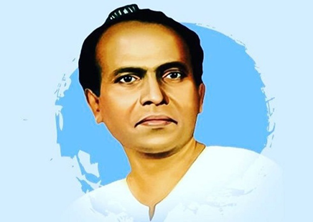Annabhau Sathe’s Statue in Moscow
- Posted By
10Pointer
- Categories
History & Culture
- Published
15th Sep, 2022
-
Context:
The statue of Lok Shahir (balladeer) Annabhau Sathe got recently unveiled at the All-Russia State Library for Foreign Literature.

Who was Anna bhau Sathe?
- Tukaram Bhaurao Sathe, who later came to be known as Annabhau Sathe, was born in a Dalit family on August 1, 1920 in Maharashtra’s Wategaon village in Satara district.
- In 1930, his family left the village and came to Mumbai. Here, he worked as a porter, a hawker and even a cotton mill helper.
- In 1934, Mumbai witnessed a workers’ strike under the leadership of Lal Bawta Mill Workers Union in which he participated.
- During his days at the Matunga Labour Camp, he got to know R B More, an associate of Dr Babasaheb Ambedkar in the famous ‘Chavdar Lake’ Satyagraha at Mahad, and joined the labour study circle.
- Being a Dalit, he was denied schooling in his village. It was during these study circles that he learned to read and write.
About His work
- Sathe and his group travelled across Mumbai campaigning for workers’ rights.
- Out of the 49 years that he lived, Sathe, who began writing only after the age of 20, churned out 32 novels, 13 collections of short stories, four plays, a travelogue and 11 povadas (ballads).
- Several of his works like ‘Aklechi Goshta,’ ‘Stalingradacha Povada,’ ‘Mazi Maina Gavavar Rahili,’ ‘Jag Badal Ghaluni Ghav’ were popular across the state.
- His ‘Bangalchi Hak’ (Bengal’s Call) on the Bengal famine was translated into Bengali and later presented at London’s Royal Theatre.
- His literature depicted the caste and class reality of Indian society of that time.
- Sathe’s work was influenced by Marxism, but at the same time he brought out the harsh realities of the caste system.
- In 1943, he formed the ‘Lal Bawta Kala Pathak’.
- The group toured across Maharashtra presenting programmes on caste atrocities, class conflict, and workers’ rights.
- He dedicated his most famous novel Fakira to Dr Ambedkar.
What was his Russian connection?
- He was a member of the Communist Party of India (CPI), and featured among the selected authors from India whose work was translated in Russian.
- Sathe’s literature is closely related to the then Communist Russian literature which was a mixture of reality and art.
- Six of his novels were turned into films and many translated into other languages, including Russian (Chitra or his famous Stalingradcha Povada on the battle of Stalingrad battle)
- In his travelogue ‘Maza Russiacha Pravas’ (My Travel to Russia), he writes that workers had come to see him off and how they wanted him to go and see slums of Russia and describe them after his return home.
- He travelled to Russia in 1961 along with a group of other Indians.
- He was once called the Maxim Gorky of Maharashtra.
- He was immensely inspired by Gorky’s ‘The Mother’ and the Russian revolution, which was reflected in his writings.
